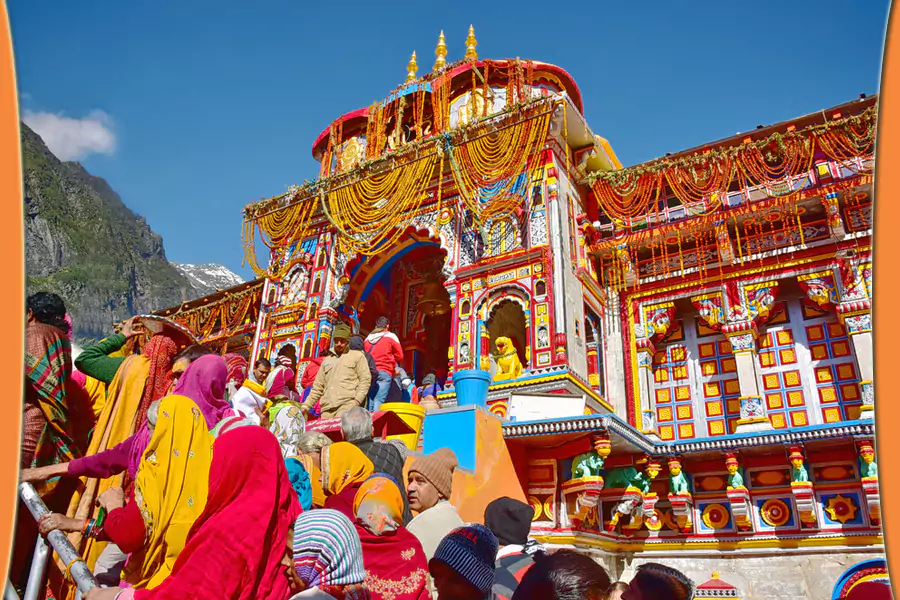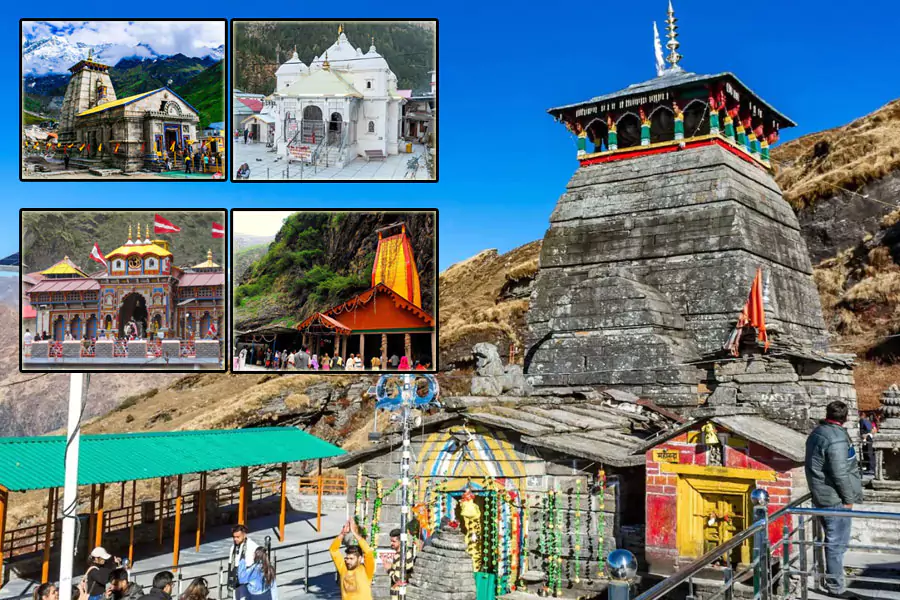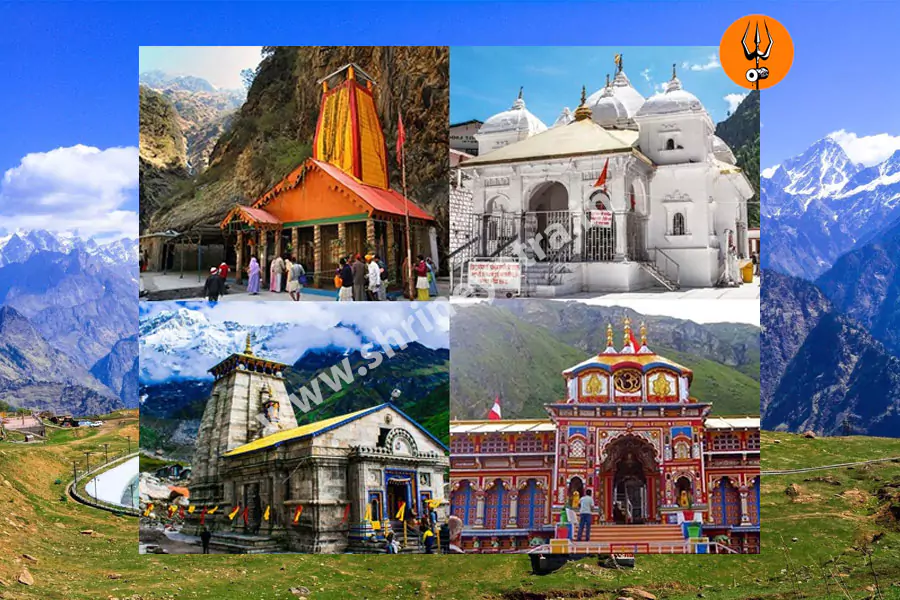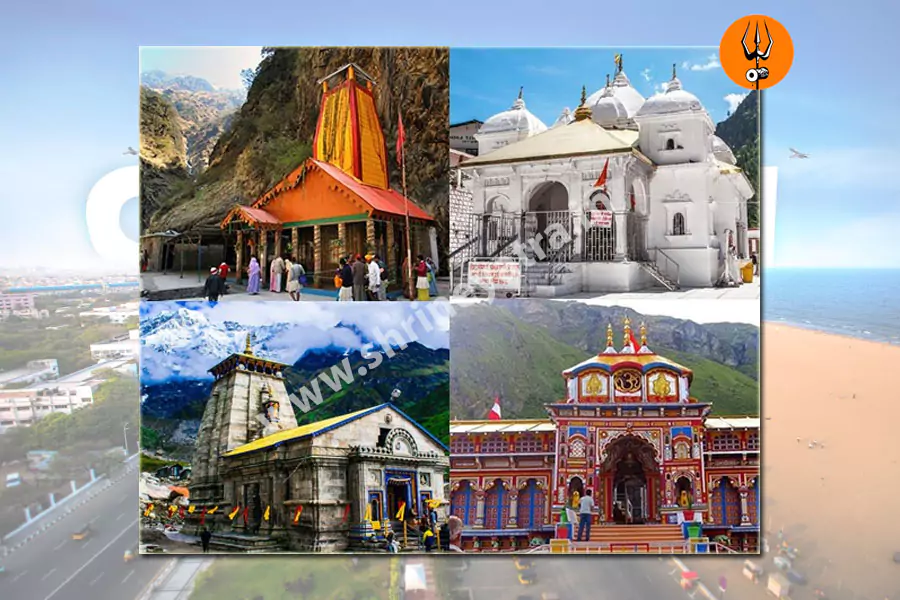Nestled in the serene embrace of Nar-Narayan Parvat, with the majestic Neelkanth Peak (6,597 meters) towering in the backdrop, Badrinath holds a significant place in Hindu pilgrimage. Known as the Vishal Badri, it is the largest and most prominent of the five Badris, dedicated to Lord Vishnu.
The establishment of Badrinath is attributed to the legendary Adi Guru Sri Shankaracharya, who sought to rejuvenate Hinduism and unify the nation through the creation of four sacred pilgrimage sites at the cardinal points of India. These included Badrikashram (the Badrinath temple) in the north, Rameshwaram in the south, Dwarkapuri in the west, and Jagannath Puri in the east. Located at an altitude of 3,133 meters, Badrinath is revered as one of the holiest shrines.
In ancient times, the region was abundant with wild berries, which led to its name "Badri Van," meaning "forest of berries." Adi Shankaracharya, the great philosopher of the 8th century, originally built the temple. Over the centuries, it has undergone several renovations due to damage from avalanches. In the 19th century, the temple was restored by the royal families of Scindia and Holkar. The entrance gate, known as the Singhdwar, is a striking and colorful feature that beckons devotees.
A series of steps leads visitors to the temple's main entrance. The temple structure is divided into three distinct areas: the 'Garbha Griha' (sanctum sanctorum), the 'Darshan Mandap' where rituals take place, and the 'Sabha Mandap' where devotees gather for prayers. The Garbha Griha is adorned with a golden canopy, a precious offering from Queen Ahilyabai Holkar. The temple houses 15 idols, the most revered being the one-meter-high idol of Lord Badrinath, sculpted in black stone, depicted in a meditative posture known as Padmasana.
Within the Darshan Mandap, Lord Badrinath is seated in Padmasana (the lotus posture of meditation). On the right side of Lord Vishnu is Uddhava, with Nara and Narayana positioned farther to the right. Narada Muni is kneeling in front, though it may be hard to spot. To the left, Kubera, the deity of wealth, and a silver Ganesh are present. Garuda, the divine eagle, kneels on the left side of Lord Badrinath.
Special prayers and rituals are conducted for individuals, and each puja is preceded by a sacred dip in the Tapta Kund, the holy thermal spring nearby. Key morning rituals include Abhishek, Mahaabhishek, and Geeta Path. Evening rituals such as Aarti and the singing of Geet Govind are also integral parts of temple worship. These pujas must be pre-booked in advance for participation. The temple opens at 4:30 AM and closes at 1:00 PM, reopening at 4:00 PM and closing again at 9:00 PM after the devotional performance of Geet Govind. The Rawal, the chief priest and administrator of the temple, is expected to be well-versed in ceremonial rites and the Sanskrit language, maintaining a celibate lifestyle.
The name "Badri" refers to the abundant berries, particularly the Jujube tree, which grew in the region. "Nath" is another term for Vishnu. Some ancient texts mention that the Jujube trees, with their nourishing berries, protected Lord Vishnu during his long meditation. Legend has it that Goddess Lakshmi transformed into these berries to shield her consort from the harsh conditions while he performed his penance.

Badrinath Temple, also known as Badrinarayan Temple, is a well-known Char Dham Temple. It is dedicated to Lord Vishnu and is located in Badrinath town. Along with the Badrinath temple, the Town of Badrinath has the Panch Badri temples including Yog Dhyan Badri, Bhavishya Badri, Adi Badri, and Vriddha Badri.The temple has North Indian style architecture with stone walls and carvings, as well as a colourful and powerful entrance gate.
Shree Badrinath Temple is divided into three sections
The Garbha Griha portion of the Badrinath shrine has its canopy covered with a sheet of gold. The complex has 15 idols especially attractive is the one-metre-high image of lord Badrinarayan, finely sculpted in black stone. It represents Lord Vishnu seated in meditative pose called padmasan. The Darshan Mandap is a place in the Temple complex where devotees and pilgrims gather to pray for good fortune. Every puja must be preceded by a holy dip in the Tapta Kund. Unlike most Hindu temples, they are performed in the presence of the devotees.About Badrinath Temple
The Badrinath tirtha derives its name from the native word Badri, which refers to a variety of wild berry. Badrinath temple history has its own uniqueness and Legendaryness. There are a lot of tales about Badrinath temple. It is stated that when Lord Vishnu sat in penance in these mountains, His spouse Goddess Laxmi took the appearance of a berry tree and shielded Him from the fierce sun. It is not only the Lord’s dwelling place, but also the abode of countless pilgrims, saints, and sages who come to meditate in search of enlightenment.
According to SkandPuran the idol of Lord Badrinath was recovered by Adiguru Shankaracharya from NaradKund and was re-enshrined in the 8th century A.D. in this temple. Skanda Purana describes more about the place and says: “There are several sacred shrines in heaven, on earth, and in hell; but there is no shrine like Badrinath.”
In the history of Badrinath, the sages Nara and Narayana, the ‘fifth avatar of Lord Vishnu’, practised penance in the temple, according to the Vamana Purana. The religious narratives from several ancient Hindu scriptures abound in Badrinath. According to mythic, Badrinath is often called as Badri Vishal, and was a place of pilgrimage for Hindus. History of Badrinath
The Gates of the Badrinath temple opens every year for the pilgrims, devotees and tourists from around the world in the month of April-May, It mainly gets open in the last week of April or first week of May (the opening date of Badrinath is decided on the auspicious occasion of Basant Panchami by the temple priests) and closes for winters in the third week of November (the closing dates are fixed on Vijayadashmi). Thus the temple is shut down for 6 months during the winters due to extreme climatic conditions every year during which prayers to the Badri Vishal continue at the Narsimha temple in Joshimath.
Opens at 4:30 AM for morning poojas called the Abhishek Darshan, Alankar Darshan, Aarti Darshan and closes in the afternoon at 1 PM. There is an afternoon recess from 1 AM to 4 PM. The temple reopens at 4 PM and closes again by 9 PM. The evening pooja ends with Mangal aarti also called Geet govind. After the grand aarti the temple priest removes the flowers & jewels from the image of Badrinarayan. Only the sandal paste is left which is removed next morning and distributed as Prasad among the devotees. Open/ Close Date of Badrinath Temple
The two mountains Nar and Narayan surround the Badrinath Dham making the location a majestic sight and the most important of all the Char Dhams. Badrinath Dham is a popular Hindu holy town in Chamoli district in the state of Uttarakhand, India. It is located at an elevation of 11204 feet (3415 metres), in the shadow of the Neelkanth Peak, Badrinath is a holy hindu pilgrimage situated on the banks of Alaknanda river.
This town is well-served by all major forms of transportation, including air, rail, and road. There is no direct bus or train service to Badrinath. To get to Badrinath, you must first travel to Haridwar/Rishikesh from where you may easily catch a direct bus or taxi to Badrinath.
There are regular buses operating to Badrinath from Delhi, Haridwar and Rishikesh. Well connected to Haridwar, Rishikesh, Dehradun, Dev Prayag, Rudra Prayag, Kotdwar, Joshi Math and other hill stations of Garhwal and Kumaon region. The location of Badrinath is easily accessible by road as compared to airways and railways. It is located at a distance of 525 Km from Delhi & 296 Km from Rishikesh. Badrinath Location
Badrinath is a Hindu holy town and a nagar panchayat in Chamoli district in the state of Uttarakhand, India. It is located at an elevation of 11204 feet (3415 mts), in the shadow of Nilkanth Peak and between Nar-Narayana Hills, Badrinath is a holy hindu pilgrimage situated on the banks of Alaknanda river.
Badrinath Popular Route: Delhi → Haridwar (206 km) → Rishikeh (24 km) →) Deoprayag (71 km) → Kirtinagar (30 km) → Shrinagar (4 km) → Rudraprayag (34 km) → Gauchar (20 km) → Karnaprayag (12 km) → Nandprayag (20 km) → Chamoli (11 km) → Birahi (8 km) → Pipalkoti (9 km) → Garur Ganga (5 km) → Helang (15 km) → Joshinath (14 km) → Vishnuprayag (13 km) → Govindghat (8 km) → Pandukeshwar (3 km) → Hanumanchatti (10 km) → Shri Badarinath Ji (11 km).
Essential items for your Badrinath Dham Yatra: Stay prepared with the right gear, clothing, and essentials to ensure a safe, comfortable, and spiritually enriching journey in 2025.
Important Note: Registration is compulsory for Char Dham Yatra.

Chardham Yatra Package from Bangalore (11 Night & 12 Days)

Chardham Yatra with Tungnath Tour from Haridwar (10 Night & 11 Days)

Chardham Yatra with Hemkund Sahib from Haridwar (12 Night & 13 Days)

Chardham Yatra with Auli Tour from Delhi (12 Night & 13 Days)

Chardham Yatra Package from Pune (11 Night & 12 Days)

Chardham Yatra Package from Chennai (11 Night & 12 Days)
Explore the budget frendly Char Dham pilgrimage with our specially curated packages.
Complete the booking form to begin your spiritual journey today.
Your enquiry will be sent to our sales team who will reach out to you with a relevant tour package offer. Package prices are subject to change as per accommodation, tour date, and group size.
